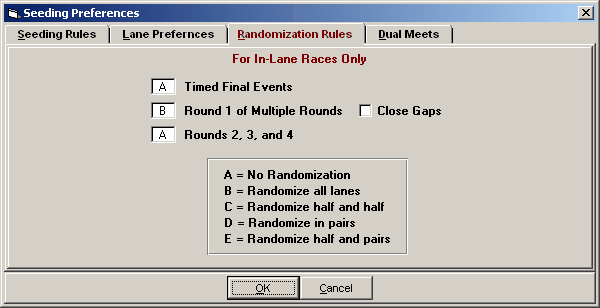From the Main Menu bar, click Set-up / Seeding Preferences and click on Randomization Rules

The randomization rules are used during seeding of events and only apply to events which are run entirely in lanes.
| The rules are only used when you select standard lanes or custom lanes as the method to assign lanes in a particular event. The lane preferences determine what lane each athlete gets, and then the rules determine what lanes get randomized (mixed) during each round of seeding. |
There are four randomization rules which apply to 3 types of rounds. Assign them to according to your particular needs. The three types of rounds are:
| 1. | Timed Final events. |
| 2. | Round 1 of multiple rounds. |
| 3. | All Successive Rounds following the first round. |
The four randomization rules, which only apply to running events of 800 meters or less and relays of 3200 meters or less, are:
| A. No randomization. |
| B. Randomize all lanes (optionally close gaps). |
| C. Randomize half and half. |
| D. Randomize in pairs. |
| E. Randomize half, half again, and remaining. |
E is a new choice effective with January, 1, 2008 IAFF rules. If there are an odd number of lanes, C, D and E will randomize the leftover lane with the last pair or second half. For example, in rule C, if the event is using 9 lanes and the lane preferences are 5-4-6-3-7-2-8-1-9, lanes 5-4-6-3 will be randomly mixed and then lanes 7-2-8-1-9 will be randomly mixed. Rule E will randomize as follows: if 5 lanes, then randomize the fastest 2 and then the remaining 3; if 6 lanes, then randomize the fastest 3, then the 4th fastest and then the remaining 2; if 7 lanes, then randomize the fastest 3, then the next two fastest and then the remaining 2; if 8 lanes, then randomize the fastest 4, then the next two fastest and then the remaining 2; if 9 lanes, then randomize the fastest 4, then the next two fastest and then the remaining 3; if 10 lanes, then randomize the fastest 5, then the next two fastest and then the remaining 3;
If randomize all lanes choice B is selected for the first round of multiple rounds, there will be a choice to close empty lane gaps or not. To explain what close gaps means, suppose there are 8 lanes, but only 7 runners in the heat. Randomizing all lanes would mean that the one empty lane could be any one of lanes 1 through 8. Let's say the empty lane happened to be lane 5. Depending on the meet committee's interpretation of the rules, the decision has to be made whether to move (close the gap) lanes 6, 7, and 8 into 5, 6, and 7 or to leave lane 5 open. In any case, MM can handle either interpretation of the rules automatically.